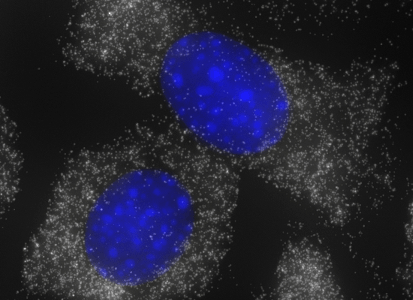Stellaris® FISH Probes, Mouse Gapdh with Quasar® 570 Dye
Mouse Gapdh consists of a set of Quasar® 570-labeled oligos mixed at equal ratios and pooled into a final delivered amount of 1 nmol, which yields approximately 80 hybridizations under standard conditions. Designed to detect Gapdh transcripts in Mouse specimens using fluorescence in situ hybridization (FISH).
Design Criteria: Product was designed against Mouse glyceraldehyde-3-phosphate dehydrogenase, Gapdh, a.k.a. G3PD; Gapd; (NCBI gene ID: 14433), and the coding sequence of NM_008084.2 nts 51-1052.The probe set has not been tested for potential cross-hybridization to RNA(s) of paralogous and orthologous gene(s) in the same or other species.
Representative image of mouse Gapdh mRNAs detected with a Quasar 570 dye labeled probe set in NIH 3T3 cells
Properties:
- Absorption Maximum (Lambda Max):
- 548
- Fluorescence Maximum:
- 566
Product usage:
- Additional information:
- Please note that reconstituted probe mix should be subjected to a minimum number of freeze-thaw cycles. For daily and short-term use, the mix can be stored at +2 to +8 °C in the dark for up to a month.
For long-term use: We recommend freezing reconstituted probes in the dark at -15 to -30 °C for storage lasting longer than a month.
Protocols: Detailed protocols by sample type can be found here: https://www.biosearchtech.com/stellarisprotocols.
Storage and handling:
- Storage conditions:
- Stellaris FISH Probes are shipped dry and may be stored at +2 to +8ºC in this state.
Trademarks
Biosearch, the Biosearch Technologies logo, Black Hole Quencher, BHQ, BHQplus, CAL Fluor, Quasar, Pulsar, Stellaris and SuperROX are registered trademarks of Biosearch Technologies, Inc.
Permitted Product Usage
All products offered for sale by Biosearch Technologies, Inc. (BTI) are sold under the condition that they be used for research purposes only and are prohibited from use in diagnostic or other commercial applications unless explicitly authorized by separate written agreement with BTI.
Black Hole Quencher® (BHQ), CAL Fluor®, Quasar® and Pulsar® dyes (referred to collectively as “BTI Dyes”) are sold to the purchaser only for internal R&D use, and are not to be used for clinical or diagnostic purposes. Neither the BTI Dyes nor the compounds synthesized with them are to be re-packaged or re-sold. Separate licenses to the BTI Dyes may be available for applications other than the aforementioned internal R&D. Please inquire via info@biosearchtech.com.
Patents
The Black Hole Quencher dye technology is protected in the United States and other countries by U.S. patents and continuations numbered 7,019,129, 7,019,129B1, 7,109,312B2, 7,582,432, 8,410,255B2 and 8,440,399B2 issued to Biosearch Technologies, Inc. The CAL Fluor technology is covered by U.S. patent number 7,344,701B2. The Quasar technology is covered by U.S. Patent numbers 7,705,150B2, 7,868, 157B2 and 8,436,153B2. The Pulsar technology is covered by U.S. Patent numbers 7,635,762B2 and 8,119,781B2.
Supercolumns are protected by U.S. Patent 6,761,855 B1, "Column for solid phase processing" issued to Biosearch Technologies, Inc. Contact licensing@biosearchtech.com for more information. Supercolumns for use on ABI 3900 or equivalent rotary cartridge style shoulder mount design are also manufactured under license from McLuen Design, U.S. Patents 8,158,085 and 8,404,196.
Stellaris products are sold under license from Rutgers University and may be used under its patent rights for Research Use Only.
Licensing
Information on licensing programs for the commercial and/or diagnostic use of these products is available by contacting licensing@biosearchtech.com.
Please visit our legal webpage on www.biosearchtech.com for full legal disclosure.

 {{item.message}}
{{item.message}}
